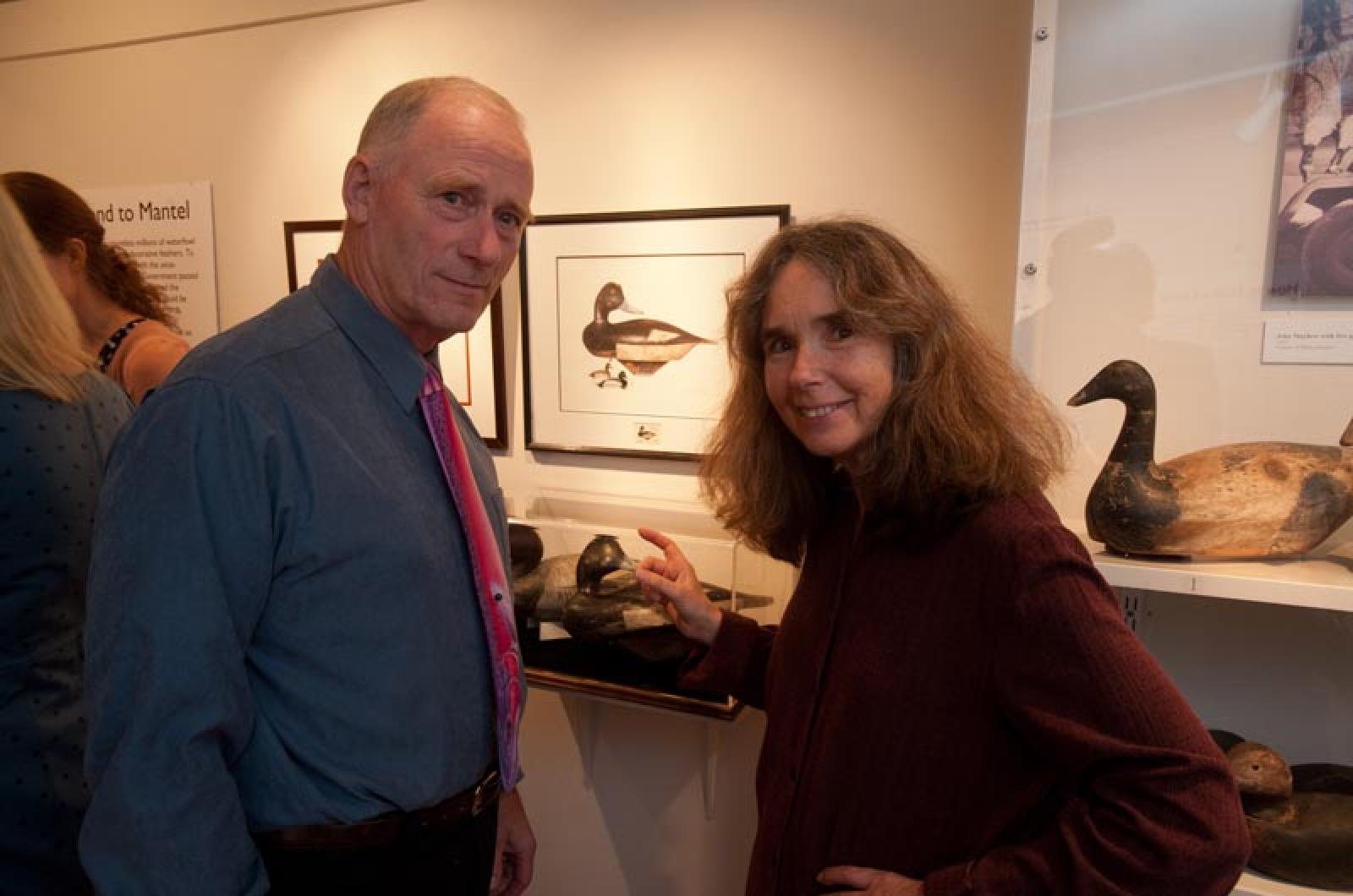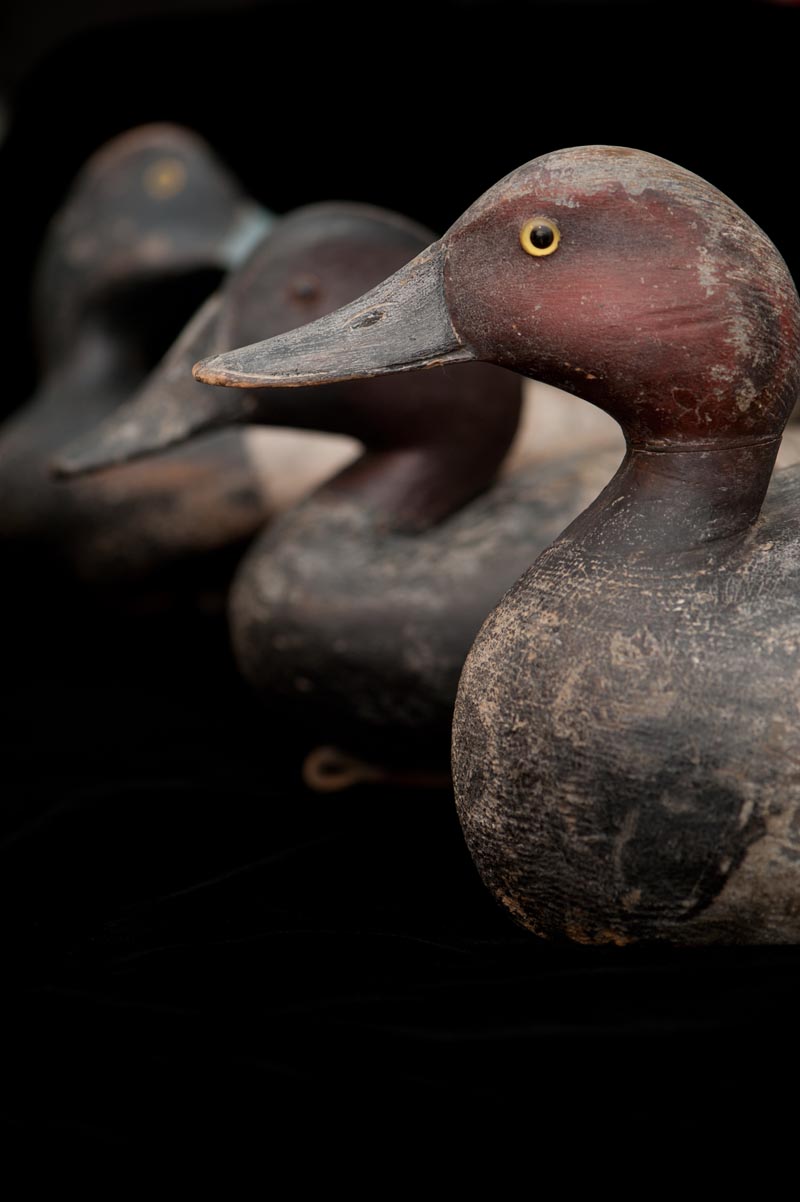A big slice of the way things used to be on the Vineyard is shared in a new exhibit of duck decoys which opened last weekend at the Martha’s Vineyard Museum. It is a story that goes back centuries, to a time when many of those residing on the Island were engaged in sustenance living, and when food delivered hot and freshly prepared to the dinner table had to be first hunted and harvested.
The Art of the Hunt: Martha’s Vineyard Decoys is a big story contained in a small exhibition room in the Pease House at the museum, located in Edgartown at the corner of School street, near the intersection of Cooke street. The display opened last Friday for members and for the general public on Saturday.
The show has many moving parts. It highlights the lives of duck decoy carvers and hunters. It is a story about an appreciation for birds and the craftsmanship they inspired. The stories are preserved in wood, photographs, ink and pencil.
The exhibit was created by Chris Murphy of Chilmark; Bonnie Stacey, museum curator; Anna Carringer, assistant curator and Linsey Lee, oral historian. The hardest part of assembling the exhibit wasn’t what to put in the show. The challenge was deciding what had to be left out for lack of room. The topic is large and the people it touched extensive. Each decoy has a story.
There are 61 decoys in the museum collection, with an additional six on loan. The limited exhibition space allowed for displaying only half of them.
The earliest residents of the Vineyard relied on fish and shellfish, together with garden-grown fruits and vegetables. Hunting ducks and other waterfowl is part of the culinary story.
From the 1800s and well into the 1940s, there were local hunting camps, as the Vineyard hosted large numbers of migrating birds. Long Point in West Tisbury, which is owned and managed by the Trustees of Reservations, was at one time valued as a hunting camp.
Linsey Lee has recorded the voices of hundreds of Vineyard residents and many of her subjects were hunters. These recordings are a key ingredient to this exhibit.
“I am not a hunter,” said Ms. Lee. “But I realized talking to those that did, that the hunters had a great appreciation for the beauty of what was going on outside. They had a special enjoyment of the beautiful air and what was to be seen on this beautiful Island.”
“This goes back to the days of the Depression, when they did their hunting out of necessity,” she said. Through this exhibit you get the sense of people connected to the landscape, she said. “They are all living close to nature.”
At the exhibit, one can pick up an electronic device and it is like sitting around a potbelly stove, hearing the voices of these old hunters. Herbert Hancock, who once worked as a lobsterman out of Menemsha, is included. There is also Ed Tyra, of Edgartown, along with many others.
Ham Luce, 79, who spent nearly a lifetime at Pohogonut as a caretaker and hunter, was recorded in 1984.
“You know, people that are not gunners do not realize that to a lot of people, including myself, killing was not important at all. I never got a big kick out of killing something,” Mr. Luce said in his interview with Ms. Lee. “Hunting with me, the pleasure, I always found, was the anticipation of going out with companions, and enjoying the beautiful autumn weather and the foliage and whatever goes with it. Just such a great time of the year to be out.”
David Nathans, executive director of the museum, said that what especially pleases him about this exhibit is that it showcases a piece of the Vineyard’s social fabric.
“This is a unique social history course, told partly through objects. It was how primarily men used to get together and enjoy the hunt, enjoy carving and deploy their decoys. And, enjoy each other’s company.”
Anyone who appreciates going jogging with friends, anyone who takes to hiking or climbing will appreciate the company that exists between hunters, Mr. Nathans said. “It is not just about the hunt, it is about people getting together and having a conversation.”
“This is told through three dimensional carvings, through two dimensional photographs and drawings and through the spiritual dimension, through their voices,” Mr. Nathans said.
For Ms. Carringer it was a bit difficult for all the right reasons.
“The challenge was absolutely trying to fit a story into a small room,” she said. “Every story is an onion. You can keep peeling it back. Bonnie and I were gnashing our teeth and pulling our hair, trying to keep from pulling the ducks out of the exhibit room,” she said. “There are 15 decoys on a table behind me that wanted to go in,” she said.
For Mr. Murphy, a semi-retired commercial fisherman who sails the catboat Vanity for the museum, this was a story he has known since youth. His father, Stanley Murphy wrote and published a book on decoys in 1978.
As he became more immersed in the topic, Mr. Murphy realized how much the community could help with this story.
“There are people out in the community who knew these wood carvers. Nobody is alive today who can speak about who made a decoy at the turn of the century. But they might know something that was passed on,” he said. “If I can pull a few more pieces together, a hundred years from now there will be a great benefit. I feel this exhibit is the first step. Working with wonderful people at the museum, this is a first step to reach out to the community.”
This exhibit will remain open as part of the museum’s winter schedule: Monday through Saturday 10 to 4 p.m. The exhibit ends on March 23, 2013. Admission is free for museum members. For nonmembers, the charge is $6 for adults; $5 for seniors; $4 for youth from 6 to 15 years of age. Under six are free. For more information call 508-627-4441.





Comments
Comment policy »